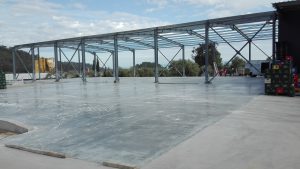METAL BUILDINGS
A FEW WORDS ABOUT METAL BUILDINGS
Metal buildings (mixed constructions) have steel as the main building material for their construction and reinforced concrete as secondary (it is only used in floor slabs). Steel as a building material has a wide range of advantages, such as durability to earthquakes, low maintenance cost, short completion time and possibility of future expansions.
The buildings we construct are bioclimatic, they belong to energy class B+ according to the recent Energy Performance of Buildings Directive (EPBD) and they can support any architectural design, since there is a wide diversity in steel cross-sections and they are characterized by increased thermal insulation levels.
They have a heat permeability coefficient U=0.25W/m2K as opposed to conventional construction that has U=0.50W/m2K. In this way, you save money and achieve more efficient heating.
CONSTRUCTION COST
The cost of metal constructions is approximately 30% lower than the cost of conventional constructions. This is due to a lot of factors, such as:
- The building of a metal construction involves a 60% lower Social Insurance Institute rate, given that the metal construction belongs to the category of pre-fabricated buildings.
- The nature of the construction is such that the transport cost of materials and equipment to and from the worksite is the lowest possible.
- A typical metal construction is completed in 4-5 months. Therefore, there are up to 50% lower wage costs.
- Reduced needs for foundation and excavations, due to the small loads of the load bearing structure. More specifically, the weight of a metal construction is 1/5 of the weight of a conventional building.
ADVANTAGES
The metal residence, which is very popular abroad, is becoming more and more popular in our country as well, as it combines an indisputable range of advantages, such as:
- Short completion time
- Steel constructions are designed exclusively on the computer and are assembled in the factory. Moreover, the fact that there is no time spent on the construction of large foundations and superstructure, combined with side-covering and internal separation materials, causes a significant reduction in the completion time of the construction.
- Environmentally friendly
Building steel is an environmentally friendly material. Plasterboard, OSB and mineral wool are also recyclable, thus protecting the environment and yourself. - Durability to natural disasters
Metal constructions have the greatest proportion of force to weight comparatively to any other material; thus they make your house resistant to natural disasters. - Possibility of expansion
A metal residence weighs approximately 1/5 of a conventional one. Therefore, the addition of extra floors is easier than in a conventional construction. - Life span
It is particularly high, exceeding by far the 50-year life span of conventional constructions. - Anti-seismic construction
Metal constructions are considered to be extremely durable, mainly because they are much lighter (1/5) than conventional ones. Therefore, they react more efficiently than conventional constructions. - Lower maintenance cost
Maintenance costs are almost zero, as there is no wear in the metal framework nor in the insulations, such as mold or warping. - Low living expenses
Insulation is achieved with a heat permeability coefficient U=0.25 W/m2K as opposed to the metal construction that has U=0.50 W/m2K. As a result, there are lower heating expenses in comparison with a conventional residence. Coating materials such as plasterboard, OSB, XPS (Extruded Polystyrene) and mineral wool are specially designed for high levels of sound and thermal insulation. - Quality of construction
The metal framework is produced according to strict standards of quality control, thus minimizing construction mistakes that are often made during the building of conventional constructions. - Quality of life
Quality in the interior of the building is guaranteed, since metal constructions do not contain resins and chemical adhesive substances that can be found in other building materials. The coexistence of heraklith and perlite makes the building ‘breathe’ and ensures high air quality.More useful square meter. More specifically, a reduction of up to 5% of useless spaces is achieved, due to load bearing elements (pillars, beams, walls).



